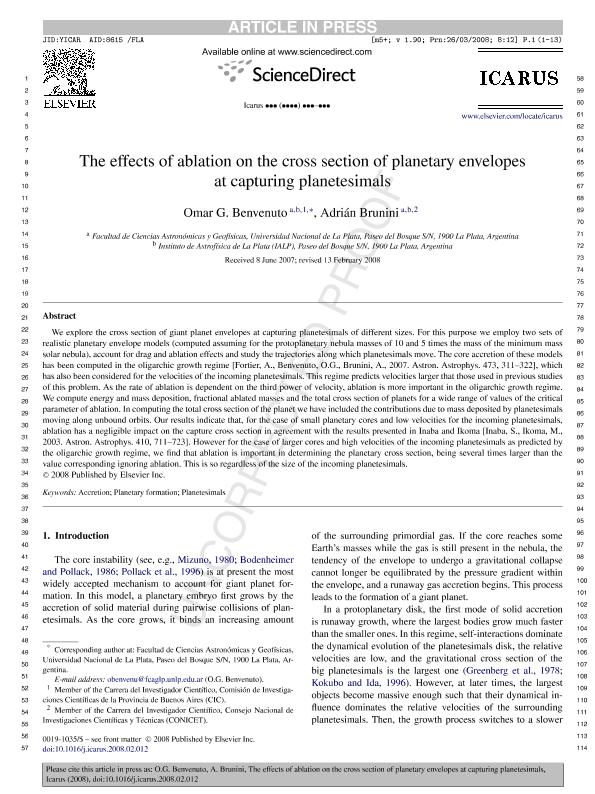Mostrar el registro sencillo del ítem
dc.contributor.author
Benvenuto, Omar Gustavo

dc.contributor.author
Brunini, Adrian

dc.date.available
2018-05-04T12:55:35Z
dc.date.issued
2008-02
dc.identifier.citation
Benvenuto, Omar Gustavo; Brunini, Adrian; The effects of ablation on the cross section of planetary envelopes at capturing planetesimals; Academic Press Inc Elsevier Science; Icarus; 195; 2; 2-2008; 882-894
dc.identifier.issn
0019-1035
dc.identifier.uri
http://hdl.handle.net/11336/44108
dc.description.abstract
We explore the cross section of giant planet envelopes at capturing planetesimals of different sizes. For this purpose we employ two sets of realistic planetary envelope models (computed assuming for the protoplanetary nebula masses of 10 and 5 times the mass of the minimum mass solar nebula), account for drag and ablation effects and study the trajectories along which planetesimals move. The core accretion of these models has been computed in the oligarchic growth regime [Fortier, A., Benvenuto, O.G., Brunini, A., 2007. Astron. Astrophys. 473, 311–322], which has also been considered for the velocities of the incoming planetesimals. This regime predicts velocities larger that those used in previous studies of this problem. As the rate of ablation is dependent on the third power of velocity, ablation is more important in the oligarchic growth regime. We compute energy and mass deposition, fractional ablated masses and the total cross section of planets for a wide range of values of the critical parameter of ablation. In computing the total cross section of the planet we have included the contributions due to mass deposited by planetesimals moving along unbound orbits. Our results indicate that, for the case of small planetary cores and low velocities for the incoming planetesimals, ablation has a negligible impact on the capture cross section in agreement with the results presented in Inaba and Ikoma [Inaba, S., Ikoma, M., 2003. Astron. Astrophys. 410, 711–723]. However for the case of larger cores and high velocities of the incoming planetesimals as predicted by the oligarchic growth regime, we find that ablation is important in determining the planetary cross section, being several times larger than the value corresponding ignoring ablation. This is so regardless of the size of the incoming planetesimals.
dc.format
application/pdf
dc.language.iso
eng
dc.publisher
Academic Press Inc Elsevier Science

dc.rights
info:eu-repo/semantics/openAccess
dc.rights.uri
https://creativecommons.org/licenses/by-nc-sa/2.5/ar/
dc.subject
Giant Planets
dc.subject
Formation of Planets
dc.subject
Planetesimal
dc.subject.classification
Astronomía

dc.subject.classification
Ciencias Físicas

dc.subject.classification
CIENCIAS NATURALES Y EXACTAS

dc.title
The effects of ablation on the cross section of planetary envelopes at capturing planetesimals
dc.type
info:eu-repo/semantics/article
dc.type
info:ar-repo/semantics/artículo
dc.type
info:eu-repo/semantics/publishedVersion
dc.date.updated
2018-04-23T15:36:02Z
dc.journal.volume
195
dc.journal.number
2
dc.journal.pagination
882-894
dc.journal.pais
Estados Unidos

dc.journal.ciudad
New York
dc.description.fil
Fil: Benvenuto, Omar Gustavo. Universidad Nacional de La Plata. Facultad de Ciencias Astronómicas y Geofísicas; Argentina. Consejo Nacional de Investigaciones Científicas y Técnicas. Centro Científico Tecnológico Conicet - La Plata. Instituto de Astrofísica La Plata. Universidad Nacional de La Plata. Facultad de Ciencias Astronómicas y Geofísicas. Instituto de Astrofísica La Plata; Argentina
dc.description.fil
Fil: Brunini, Adrian. Universidad Nacional de La Plata. Facultad de Ciencias Astronómicas y Geofísicas; Argentina. Consejo Nacional de Investigaciones Científicas y Técnicas. Centro Científico Tecnológico Conicet - La Plata. Instituto de Astrofísica La Plata. Universidad Nacional de La Plata. Facultad de Ciencias Astronómicas y Geofísicas. Instituto de Astrofísica La Plata; Argentina
dc.journal.title
Icarus

dc.relation.alternativeid
info:eu-repo/semantics/altIdentifier/doi/http://dx.doi.org/10.1016/j.icarus.2008.02.012
dc.relation.alternativeid
info:eu-repo/semantics/altIdentifier/url/https://www.sciencedirect.com/science/article/pii/S0019103508000845?via%3Dihub
Archivos asociados
